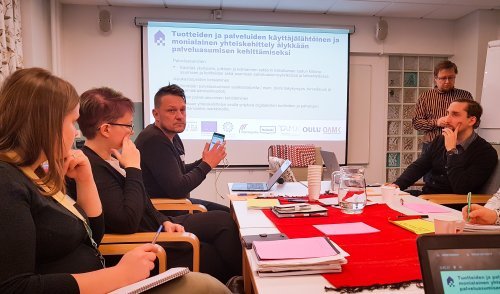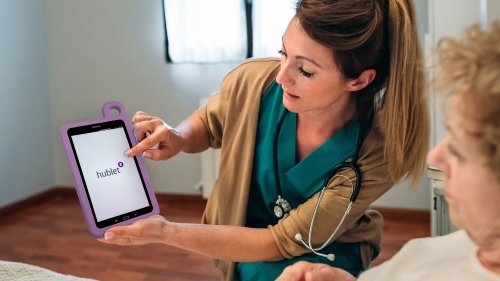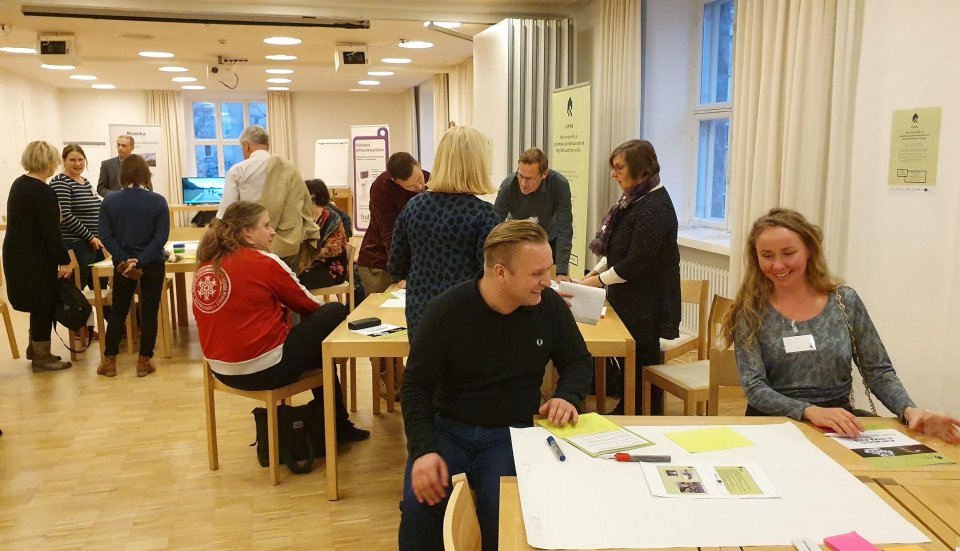
Developers’ Clubs mode of operation emerged during the HIPPA project, Well-Being and Better Service Housing through Digitalisation. The UAS involved in the project, Metropolia UAS, Tampere UAS and Oulu UAS have developed and modelled it amongst themselves, and also together with their own stakeholders and collaboration partners. The developed model can be widely applied in supporting companies’ product and service development, or network-based collaboration in general.
Developers’ Clubs anchor regional development activities
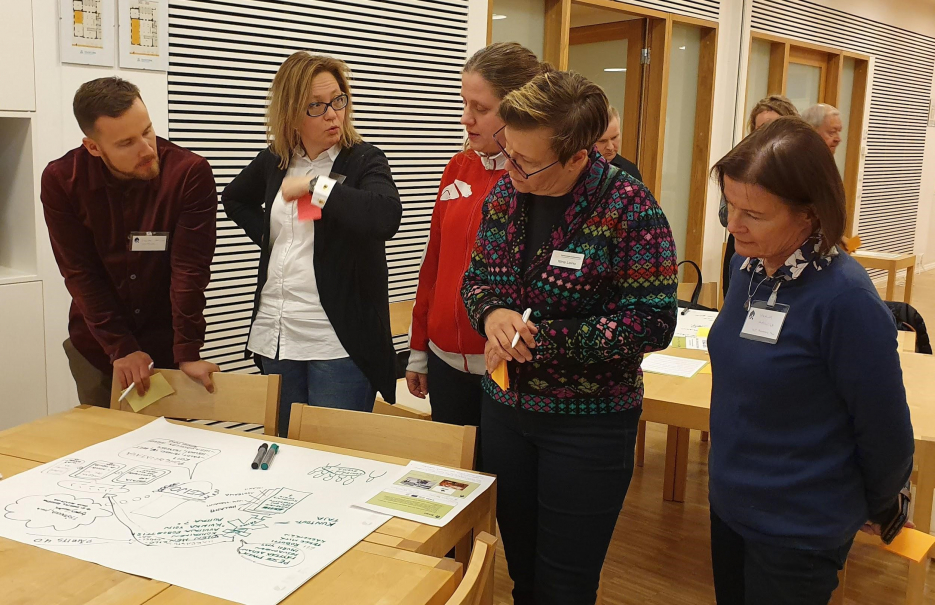
Developers’ Clubs are regional and open events for individuals, students, companies and organisations interested in developing digital products and services. Universities of applied sciences, either alone or together with municipal partners, have convened or organised these events. The invitations have been sent as personal email invitations to known interested parties, or published on the project’s, the UAS and municipalities’ websites, and openly in social media channels.
The objective of the Club is to promote companies’ user-driven and multidisciplinary product and service development. In the events, the participants have demonstrated latest research results and best practices, gathered together regional development needs, discussed the conditions and meaning of constructing more extensive product and service entities, as well as strengthened the networking of the participants and regional developers’ networks. Developers’ Clubs have sometimes introduced and disseminated the project’s results already during the development process. Due to pandemic, Developers’ Clubs have also been organized online.
The UAS offer an impartial platform for development activities and, at the same time, the students have an opportunity to discuss both the development needs and solutions to them. Co-creation has been the cornerstone of Metropolia UAS Developers’ Clubs. Short, introductory presentations by experts have been used to tune the participants in the subject. Participatory methods used in co-creation have brought up new and unexpected perspectives, and helped the participants understand each other’s diverging views. Implementation has followed the following structure: after the introductory presentations, the participants have deepened their joint understanding of the subject or planned the next steps of the development activities in smaller groups by using, for example, the learning café or anticipation dialogue method. Different, easily applicable methods for co-creation are presented on, for example, the Innovation Village website or in CoHeWe project’s co-creation guide (only in Finnish).
How to implement Developers’ Clubs activities
Today’s societies have complex challenges and solving them requires multidisciplinary action and approaches of different administrative and scientific fields, and organisations. According to Vataja (2018), “innovations aimed at systemic change are often generated in networks of different actions, actors and environmental factors and as a combined effect of them, which makes them complex”. Complex systems are, according to Vataja, constantly changing organisms, i.e. amoeba-like systems with multi-directional and unanticipated causal connections, whose changes will be visible only after a long time. Due to complexity, unanticipated and unwanted consequences must be recognized in the impact assessment (Vataja 2018). In her opinion, instead of merely describing “if…then”, we should ask “what if?” Developers’ Clubs are an example of such amoeba-like, constantly changing and evolving systems. They are implemented by co-creation which allows us to ask the “what if” question. They are constantly evolving, network-based activities, whose focus, stakeholders and participants may change whenever needed!
Next, we will shortly describe the main steps in the Developers’ Clubs process.
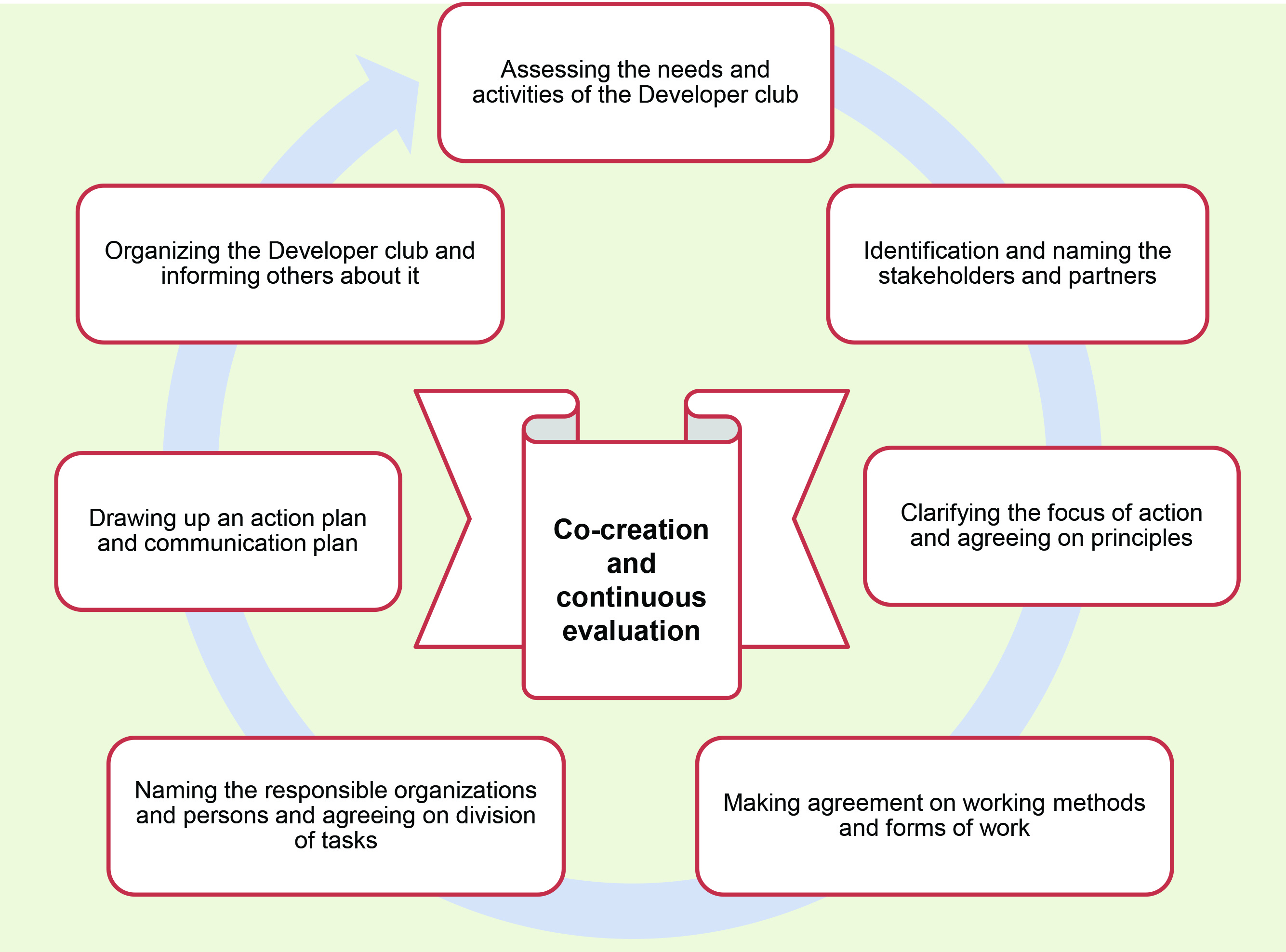
Process of Developers’ Clubs activities (Figure 1) consists of seven mutually complementing phases that are:
- Assessment of the need and the activities of a Developers’ Club
- Recognizing and identifying stakeholders and collaboration partners
- Fine-tuning the focus of activities and agreeing on principles
- Agreeing on working methods and working modes
- Appointing the responsible organisations and individuals and agreeing on the division of tasks
- Drafting an action and communication plan
- Organizing the Developers’ Club and communicating its activities
The collaboration starts by assessing the need and the activities of a Developers’ Club. After that, the assessment becomes continuous and constructive, with which it is possible to fine-tune the focus of activities and recognize the needed stakeholders. Continuous, reflective assessment helps specify the purpose and objective of the Clubs, which helps in responding to present-day challenges. The focus of activities, the nature of the context and the need for information have an impact on the identity of collaboration partners to be invited to participate in different situations. The partners are expected to bring their versatile and non-conventional skills and expertise and new perspectives into the collaboration. Different experts enrich the activities of the Clubs and open the doors to learning and expanding horizons. The group of responsible organisations and individuals agrees on the tasks of the Club, its working methods and working modes. For the work to be longstanding and effective, an action and communication plan and its continuous updating, based on on-going assessment, are needed. The results and activities of Developers’ Clubs work should be communicated to a wider audience, using multiple communication channels.
Significance of the Developers’ Clubs in development work
Developers’ Clubs gather together a multiperspective group of parties interested in product and service development. In the Clubs, the participants share information, gather development needs and construct a common understanding for the regional partners and developers. In order to understand and develop constantly changing and evolving everyday life, it is important to gather together individuals, companies and organisations interested in product and service development.
Developers’ Clubs help the participants recognize new development needs and opportunities. They also help in targeting the activities of UAS and municipalities that support product and service development to matters that are important from the companies’ perspective. They also expand the participants’ understanding of the opportunities and possible obstacles of development. The Clubs help like-minded participants to get to know each other and strengthen networking and cooperation.
The Developers’ Clubs help in raising awareness of product and service development, also in wider audiences. They create a place and space for the like-minded participants to interact. Meetings of multidisciplinary participants always lead to something unexpected which is important to be recognized, for the development activities to succeed. Developers’ Clubs create value and a space to verbalize the needs of everyday life, and a channel to strengthen the significance of making an impact.
More information:
On Developers’ Clubs and their activities in the HIPPA project: HIPPA project blog and in TUTTUnet.
Co-creation tools in Finnish: Innokylä (only in Finnish)
Kauppinen S., Kesäniemi E., Luojus S., Lange P. ja Lönn N. 2020. Tarpeesta ratkaisuksi - Yhteiskehittämisen opas sosiaali- ja terveydenhuollossa. (Co-creation Guide in Social and Health Care, only in Finnish). Forum Virium Helsinki and Laurea UAS. (only in Finnish(
Writers
Leila Lintula, M. Sc. in Health Sciences, occupational therapist, Metropolia UAS
Toini Harra, Doctor of Social Science, Lic. Phil., occupational therapist, Metropolia UAS
Panu Karhinen, M. Sc. in Health Sciences, occupational therapist, lecturer, Metropolia UAS




